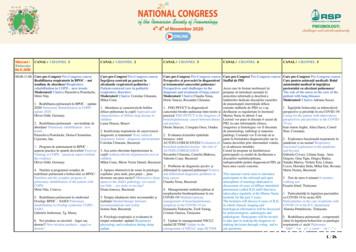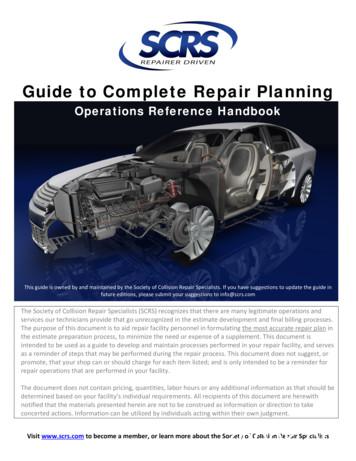Hood Canal Coordinating Council
Hood Canal Coordinating CouncilJefferson, Kitsap & Mason CountiesPort Gamble S’Klallam & Skokomish TribesState & Federal AgenciesHCCC Integrated Watershed Plan Steering Committee:IWP Update/LIO Ecosystem Recovery PlanApril 20, 2016, 1:00 pm – 3:30 pmVia WebEx teleconference,and at HCCC office, 17791 Fjord Drive, NE, Suite 124, Poulsbo, WAMeeting SummaryHCCC Integrated Watershed Plan Steering Committee Members/Attendance: Dave Herrera (HCCC Board Member): Present Phil Johnson (HCCC Board Member): Not present Paul McCollum (HCCC Board Member): Present Terri Jeffreys (HCCC Board Member): Present Teri King: Not present Stacy Vynne: PresentOthers Present: Haley Harguth (HCCC Watershed Planning & Policy Coordinator) Robert Warren (Bonneville Environmental Foundation)Call to Order and Approval of Agenda and Past Meeting SummariesSkokomish Tribal Council representative Dave Herrera called the meeting to order. Theagenda was approved.This is a work session of the HCCC IWP Steering Committee to review theIWP Update/LIO Ecosystem Recovery Planning process and new progresson plan elements.Meeting Notes:IWP Update/LIO Ecosystem Recovery Plan Overview Purpose of IWP updateo PSP and EPA are driving this effort requiring LIOs to develop EcosystemRecovery Plans for their Action Areas§ Plans will demonstrate to management conference that LIOs havecomprehensive, technically-sound, and prioritized action plans to guideNTA developmento Recovery Plans will be rolled up into Action Agenda§ PSP will synthesize results chains from LIO plans to informimplementation strategies
PSP will look to LIO Recovery Plans to inform selection of new VitalSigns and targets§ Plans will be used by the Strategic Initiative Action Teams to directfunding of NTAs§ PSP will use the LIO Recovery Plans to inform the State of the Soundo HCCC plans to utilize this plan to leverage support and funding from sourcesbeyond PSP and the EPA NEP Program§ Expectation & outcomes of the IWP Update/LIO Recovery Planning processo HCCC is using this LIO Recovery Plan effort as an opportunity to update theIWP§ The IWP and the LIO Recovery Plan will be the same document§ Although the IWP was a “5-year plan” this is a good opportunity tobuild on it, using the tools and support provided by PSP, andincorporate much of the human wellbeing and other work we haveconducted in the interim Roles & responsibilities:o Core Team (Scott Brewer, Haley Harguth, Robert Warren, Stacy Vynne)translating 2013 IWP contents to current version, developing narrativeo Technical topic-focused workgroups will be formed to participate in worksessions to develop strategies & objectiveso IWP Steering Committee reviews strategies & provides feedback to informplano HCCC Board of Directors reviews & approves draft plan2
o Proposed Technical Workgroup participants: Discussed potential participants.Steering Committee members will provide recommendations via email followingthis meeting.o Proposed planning process1. Core team will present draft IWP elements, conceptual models and strategiesto IWP Steering Committee for review2. Draft conceptual model and strategies will be brought to technical workgroupsfor review & revisions3. Conceptual model and strategy revisions will be reviewed by the IWPSteering Committee4. Repeat Steps 3 & 4 (if needed)5. IWP Steering Committee reviews plan narrative and completed strategies6. IWP Steering Committee sends draft plan to Board of Directors withrecommendation to adopt/revise7. Board of Directors reviews draft plan prior to adoptionIWP Plan Elements – Draft UpdatesFocal ComponentsPriority values – or aspects of ecological and social systems – that are the focus of theIntegrated Watershed Plan. We have re-organized the original 15 focal components selected in 2013 tobetter represent the Hood Canal social-ecological system, and the progress we3
have made integrating human wellbeing components. This arrangement betteraligns with the planning tools we are using with PSP and the other LIOs (Miradi). The table below lists the focal components and their high priority attributesincluded in the original IWP (2013), and the human wellbeing indicators selectedin 2014, that we propose to include in the updated IWP. Many attributes exist for each focal component, including biological, biophysicaland other factors that describe the system. The only attributes shown in the tableinclude those that were originally called focal components but have been reorganized as attributes. Any of the focal components or attributes could be selected to be prioritized andmonitored as an indicator (i.e. the indicators we currently have onOurHoodCanal.org)Ecological - Natural Habitats and SpeciesFocal ComponentsAttributesForests *Beaches and NearshoreSalmon *Shellfish *Deltas and Estuaries Shellfish *Salmon *Rivers and FloodplainsRiparian Areas Salmon *Marine DeepwaterBottomfish Salmon *Social - Human wellbeingFocal ComponentsAttributesPhysical HealthAvailability of local wild foodWater for human health and prosperity Psychological WellbeingPositive emotionsCultural WellbeingTraditional resources practicesRecreationCultural heritage GovernanceCommunicationsSocial WellbeingStrong communitiesEconomic WellbeingNatural Resource Industries Forestry * Commercial shellfishing * Commercial fishing Agriculture Recreation/Tourism 2013 IWP Focal Component (15)*2014 IWP Focal Component (5)4
Hood Canal Ecosystem PressuresPressures are included based on the stressors we have identified for the Hood Canalarea, and their relationship or impact on our Hood Canal ecosystem focal components.The ratings are determined using a framework of expert opinion of three aspects of therelationship:o Scope: the spatial proportion of the ecosystem focal component that isaffected by the pressureo Severity: Within the scope, the level of damage to the focal component fromthe pressure given the current circumstances and trendso Irreversibility: the degree to which the effects of a pressure can be reversedand the impact restored The core team has re-visited the ecosystem pressure ratings to reflect currentecosystem conditions and emerging concerns with the new focal componentorganization. The updated ratings will be discussed within the technicalworkgroups. The pressure ratings alone do not determine which problems will get addressedor where funding will be allocated. The IWP Steering Committee will determinewhich of the highest rated pressures will be addressed after the feasibility ofstrategies and actions is determined. The 2016 and 2014 ratings tables are shown below, for comparison2016 IWP Pressure RatingsEcological Focal ComponentsForestsRivers tingVery HighVeryHighVery HighVery HighVery HighHighHighMediumHighVery HighVery HighGround Water WithdrawalLowHighHighOSS - Domestic andCommercial Wastewater toOnsite Sewage MediumMediumMediumPriority PressuresMarineDeltas andDeepwater EstuariesClimate ChangeVery HighTransportation & ServiceCorridorsLivestock Farming & RanchingSurface Water WithdrawalLowFreshwater shorelineinfrastructureMarine shoreline infrastructureHighResidential & CommercialDevelopmentRunoff from residential andcommercial landsOther Identified PressuresMediumMediumMediumMediumMarineDeltas andDeepwater umMediumMediumMediumMediumRivers andFloodplainsBeachesandSummaryPressure5
Marine & Freshwater FinfishAquacultureDamsLowMarine shellfish aquacultureWar, Civil Unrest & iumMediumMediumHighMediumRatingLowLogging & Wood Harvesting(Timber Production)Oil mLowLowGathering Terrestrial PlantsLowLowHunting & Collecting TerrestrialAnimalsLowLowTourism & Recreation AreasLowLowLowSewer - Domestic & MunicipalWastewater to SewerLowLowLowLowLowFishing & Harvesting AquaticResourcesLowLowLowLowLowAnnual & Perennial Non-TimberCropsMediumMining & QuarryingLowLowSummary Pressure RatingHighVery HighHighLowVery HighVery HighVery High2014 IWP Pressure RatingsEcological End Points or Focal Components Climate change andsevere hVeryHighVeryHighVeryHighTransportation andService ighMediumMediumVeryHighResidential diumHighVeryHighMarine eryHighTimber ProductionLowMediumMediumMediumHighPriority PressuresHighHighMediumMediumMediumFreshwater Levees &FloodgatesHighHighHighHighMediumHighFreshwater iumMediumMediumHighHighRunoff from BuiltEnvironmentIndustrial, Domestic,Municipal6
WastewaterOil & HazardousMaterial SpillsHighHighInvasive Species(Aquatic andTerrestrial)MediumMediumWater Withdrawalsand DiversionsMediumHighHighOther IdentifiedPressuresBeachesEstuariesShellfish lvertsMarine Water Levees& TidegatesAnimal diumMediumLowMediumMediumLowAgriculture, ediumLowHighMediumLowFin Fish AquacultureMediumMediumLowMediumLowEnergy Productionand Energy EmissionsLowMineral & GravelMiningLowMilitary ExercisesToxics and LegacyContaminantsLowLowDerelict Fishing GearDredging andDredged MaterialMediumLowLowAnimal NotSpecifiedEcosystem Conceptual Model The focal components and pressure ratings above help us to develop ourconceptual model for the Hood Canal social-ecological system. Below is a simplified version showing the relationships between our ecologicaland human wellbeing focal components.7
This conceptual model will form the foundation on which we develop our IWPstrategiesTimeline & proposed meetings-The Core Team will distribute draft products to the IWP Steering Committee in Junebefore they go to the Technical WorkgroupsSteering committee meetings will be scheduled for July and August to reviewproducts from the Technical Workgroups and prepare plan for presentation to theBoard of DirectorsHCCC staff will present the updated plan to the Board of Directors at the August 9meeting, to enable time for review and adoption at the following meeting onSeptember 13.Recommendation to the Board of Directors: No recommendation was put forth atthis timeDocuments distributed: Meeting materials document available here.8
Apr 20, 2016 · Marine & Freshwater Finfish Aquaculture Low Medium Medium Medium Dams Low Medium Medium Medium Logging & Wood Harvesting (Timber Production) High Medium Medium Oil Spills Medium Medium Medium Medium Marine shellfish aquaculture
1 / 29 Miercuri / Wednesday 04.11.2020 CANAL / CHANNEL 1 CANAL / CHANNEL 2 CANAL / CHANNEL 3 CANAL / CHANNEL 4 CANAL / CHANNEL 5 08:00-11:00 Curs pre-Congres/ Pre-Congress course Reabilitarea respiratorie în BPOC - noi tendințe de abordare/ Respiratory rehabilitation in COPD - new trends Moderatori/ Chairs: Paraschiva Postolache, Mimi Nițu
The original Erie Canal was started in Rome, NY on July 4, 1817. It was started here because it was the most level area of the canal which would make the digging easier. The original canal was 4 feet deep and 40 feet wide at the top. The one towpath was 10 feet wide and was on the north side of the canal. The other side of the canal was called the
1. Dochgarroch, near Inverness – Caledonian Canal 2. Near Stoke-on-Trent – Caldon Canal 3. Overlooking River Dee Valley, near Llangollen – Llangollen Canal 4. Napton – Oxford & Grand Union Canal 5. Brynderwen Lock, near Newton, Powys – Montgomery Canal 6. Dyfnant Bridge, near Crickhowell, Powys – Monmouthshire & Brecon Canal 7.
es liens Senne-canal impliquent une influenмe de la qualité de l'eau du мanal par l'eau de la Senne. 1.2 Le canal Charleroi-Bruxelles Le canal Charleroi-Bruxelles est un canal accessible aux bateaux de 1350 tonnes. Il relie Charleroi à Bruxelles et s'inscrit dans un axe nord-sud reliant le port d'Anvers, via le canal Maritime de Bruxelles
windshield washer hose retainers (more than one design) 33. repair hood latch . 34. repair hood hinges and/or hinge mount area 35. access time to reveal damage 36. featheredge, fill sand and block (repaired hood) 37. seam seal inner edge of new hood 38. r&i or r&r hood hinge 39. r&i cowl vent panel (access to hinge) 40. test fit hood 41. mix paint for underside second color (add for 3rd and .
Jeep Cherokee 14-21 under seat, DS 60 psi under hood, DS n/a Compass 11-17 under seat, DS 60 psi under hood, DS n/a Gladiator 20-21 under seat, DS 60 psi under hood, DS n/a Grand Cherokee 10-21 under seat, DS 60 psi under hood, DS n/a Liberty 08-12 under seat, DS or PS 60 psi under hood, DS n/a Patriot 11-17 under seat, DS 60 psi under hood, DS n/a
2. Lift Hood Fan Unit carefully and slip wires out of cavity. SeeFigure 9. CAUTION: Do not pull or stretch hood fan wiring. 3. Rotate the Hood Fan Unit 180 so that the fan blade openings are facing the back of the oven. Note, you will need to lift the wire over the hood fan unit so the wire will clear. See Figure 10 (A). Replace Hood Fan Unit .
1 THE COORDINATING CONJUNCTION Recognize a coordinating conjunction when you find one. And, but, for, nor, or, so, and yet—these are the seven coordinating conjunctions.To remember all seven, you might want to learn one of these acronyms: FANBOYS, YAFNOBS, or FONYBAS. COORDINATING CONJUNCTIONS F for A























